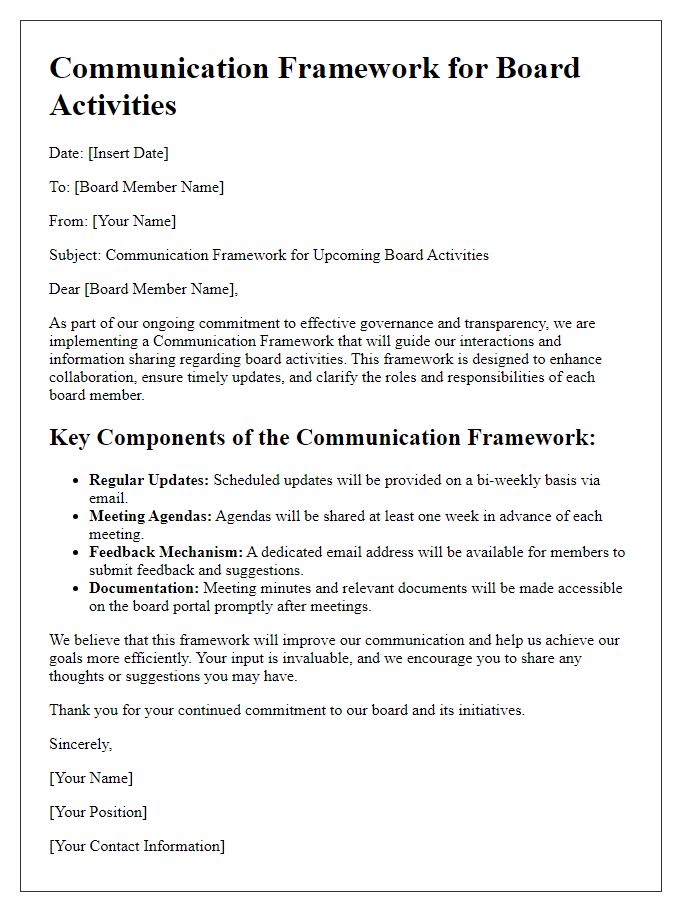In today's fast-paced world, effective communication within a board is more crucial than ever. Establishing clear guidelines ensures that every member feels informed, engaged, and valued. By fostering an environment of open dialogue, we can enhance collaboration and drive our mission forward. Ready to explore how these communication strategies can benefit your board?

Clarity and conciseness
Effective board communication guidelines emphasize clarity and conciseness in all correspondence, such as emails and reports. Clear information should be structured using bullet points and headings to enhance readability, allowing members to quickly grasp key messages. Conciseness involves eliminating unnecessary jargon and lengthy explanations, ensuring documents remain brief yet informative. Regular updates, like quarterly reports, should highlight essential data and accomplishments without overwhelming detail, fostering better understanding among board members. Adhering to these principles promotes efficient decision-making processes within organizations.
Professional tone
Effective communication guidelines are essential for maintaining professionalism within a board setting. Clear guidelines should outline the preferred channels of communication, encouraging the use of email for formal correspondence and designated platforms like Slack for quick interactions. Additionally, establish protocols for sharing meeting agendas and supporting documents at least five days prior to meetings, ensuring all members are well-prepared and informed. Set expectations for response times, recommending a 48-hour window for acknowledgment of communications. Emphasize the importance of constructive feedback during discussions, fostering an environment of respect and collaboration. Regular training sessions on communication best practices can further enhance members' abilities to engage meaningfully and professionally.
Confidentiality considerations
Confidentiality considerations in board communication guidelines emphasize the importance of safeguarding sensitive information shared by corporate executives and board members. Assigned confidentiality levels ensure discussions on financial performance (for instance, quarterly earnings reports), strategic decisions (such as mergers and acquisitions), and personnel matters (including executive recruitment) remain within the boardroom. Potential breaches can lead to legal ramifications and reputational damage, notably in high-stakes industries like finance and healthcare where privacy laws, such as HIPAA or GDPR, impose strict compliance requirements. Regular training sessions on information security protocols and designated secure channels for communication, such as encrypted emails, are vital strategies to maintain confidentiality.
Purpose and audience awareness
Effective board communication guidelines focus on purpose and audience awareness to ensure clarity and engagement. Understanding the audience includes recognizing the diverse backgrounds and expertise levels within board members, such as finance experts or industry veterans. Tailoring messages according to specific interests promotes greater involvement in discussions. The purpose of communication, whether to inform, persuade, or solicit feedback, should be clearly defined and aligned with organizational goals, such as enhancing decision-making processes and fostering collaboration among members. Utilizing structured formats, such as concise summaries and clear subject lines, aids in conveying important information, ensuring that topics like strategic initiatives and fiscal reports are easily understood and addressed in scheduled meetings.
Consistent formatting style
Consistent formatting style in board communication guidelines enhances clarity and professionalism in organizational documents. Key elements include font type (typically Arial or Times New Roman), font size (generally 12pt for body text), and line spacing (usually 1.5 or double). Additionally, document structure involves headings with clear hierarchy (H1, H2, H3) to delineate sections such as agenda items, minutes, and reports. Margins should remain uniform (usually 1 inch on all sides) to ensure readability. Incorporating bullet points or numbered lists can aid in the presentation of key information, promoting efficient information processing. Clear and concise language should be prioritized to convey messages effectively, while ensuring that any technical terms or jargon are defined within the context to maintain inclusivity.













Comments